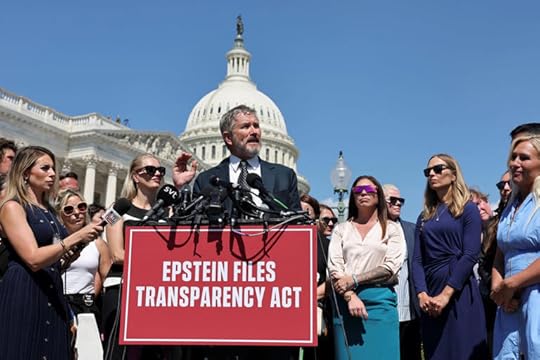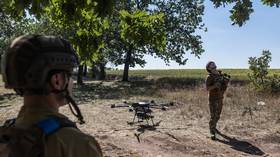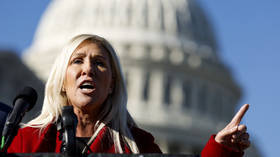Stuart Jeanne Bramhall's Blog: The Most Revolutionary Act , page 13
September 11, 2025
Vietnam to close 86 million bank accounts lacking biometric data
 Pham Anh Tuan, Director of the Payment Department, State Bank of Vietnam. Photo: LM
Pham Anh Tuan, Director of the Payment Department, State Bank of Vietnam. Photo: LM
Vietnamnet Global
V ietnam will close tens of millions of bank accounts by September 2025 under new digital payment regulations.
At a press conference for the 2025 “Cashless Day” held on June 2, Pham Anh Tuan, Director of the Payment Department at the State Bank of Vietnam (SBV), said the central bank has been actively strengthening legal and institutional frameworks to support the development of cashless payments.
With legal backing from the SBV and investments in payment infrastructure, non-cash payments have seen tremendous growth. In 2024, the total value of non-cash transactions reached over 295.2 quadrillion VND (approx. $11.57 trillion), 26 times the GDP. By the end of 2024, 86.97% of citizens aged 15 and above had bank accounts.
Compared to 2023 (87.08%), this represents a slight decline, which Mr. Tuan attributed to the ongoing data cleansing and biometric verification process.
Vietnam previously recorded 200 million bank accounts nationwide. After verification, only 113 million personal accounts and over 711,000 organizational accounts are considered active.
“This is a data-cleansing revolution,” said Tuan. “While the total number of bank accounts remains 200 million, by September 2025, once the legal framework is complete, all accounts without biometric data will be closed to prevent scams and fraud. After seven years of promoting non-cash payments, we are moving toward real efficiency.”
According to the General Statistics Office (now part of the Ministry of Finance), as of December 31, 2024, Vietnam had over 69 million adults aged 15 and above. More than 68 million of them had bank accounts, highlighting how far cashless payment adoption has come.
Tuan also noted that the 2025 “Cashless Day,” now in its seventh year, carries the theme “Non-cash payments driving digital economic development.” The event underscores that digital payments are more than just a transaction method – they are a strategic foundation connecting all sectors of the digital economy.
Cashless payments, he said, form the core of a seamless and evolving digital ecosystem, helping Vietnam move toward a modern, transparent, and inclusive economy.
In line with the national plan on developing cashless payments for the 2021–2025 period (under Decision No. 1813 by the Prime Minister), the SBV has closely collaborated with ministries, local authorities, and stakeholders to build legal frameworks, adopt new technologies, and innovate service models. This has led to a safer, more secure, and more user-friendly payment environment, enhancing customer experience and accelerating the transition to a cashless society.
During the first quarter of 2025, the interbank electronic payment system processed over 35.6 million transactions worth 81.47 quadrillion VND (approx. $3.19 trillion), up 9.6% in volume and 36.81% in value year-over-year.
Non-cash transactions rose 44.43% year-over-year, with Internet banking growing by 40.41%, mobile payments by 39.82%, and QR code transactions by 81.64%.
Vietnam now has nearly 10.4 million Mobile Money accounts, over 72% of which are held by users in rural, remote, and border areas.
As of March 31, 2025, there were 47 licensed e-wallet service providers, with about 30.27 million active e-wallets – representing 65.8% of the 46 million e-wallets issued – holding a total balance exceeding 2.8 trillion VND (approx. $110 million).
To ensure data security and transaction safety, the SBV has worked with the Ministry of Public Security to implement Government Project 06. So far, data for around 57 million loan applicants has been verified against the National Population Database, and biometric data for more than 111.8 million individuals has been cross-checked.
[…]
Rogue Republican closes in on securing signatures to bypass GOP’s Epstein block
 U.S. Representative Thomas Massie speaks during a press conference to discuss the Epstein Files Transparency bill, directing the release of the remaining files related to the investigations into Jeffrey Epstein and Ghislaine Maxwell, on Capitol Hill in Washington, D.C., U.S., September 3, 2025. REUTERS/Jonathan Ernst © provided by RawStory
U.S. Representative Thomas Massie speaks during a press conference to discuss the Epstein Files Transparency bill, directing the release of the remaining files related to the investigations into Jeffrey Epstein and Ghislaine Maxwell, on Capitol Hill in Washington, D.C., U.S., September 3, 2025. REUTERS/Jonathan Ernst © provided by RawStory By Daniel Hampton
A rogue Republican is closing in on obtaining the 218 signatures necessary to bypass GOP leadership and force the House floor to vote on releasing documents related to accused sex trafficker Jeffrey Epstein.
Rep. Thomas Massie (R-KY) has locked horns with his own party and earned fierce criticism from President Donald Trump over his quest to have the files released.
Politico reported Wednesday he inched closer to securing the votes to do just that, with the swearing in of Rep. James Walkinshaw (D-VA) who cruised to victory in a special election on Tuesday night and signed Massie’s petition a day later.
“The discharge petition in the House … is really the only mechanism to circumvent that ironclad control that Donald Trump has over my Republican colleagues,” Walkinshaw told the outlet.
With Walkinshaw’s support, Massie and fellow Rep. Ro Khanna (D-CA) need just one more House signature to complete their endeavor. And they have good odds to do just that, as a Democrat is expected to win a Sept. 23 special election in Arizona to replace the late Rep. Raúl Grijalva.
Trump has been dogged by the Epstein scandal, with a recent report coming to light that he sent Epstein a bawdy doodle for the disgraced financier’s 50th birthday. Trump insists the scandal is a Democratic “hoax.”
[…]
Indonesia’s War of Independence Against the Dutch
Indonesia: Selling a Colonial War
Al Jazeera (2025)
Film Review
Prior to declaring independence, the islands of Indonesia (aka the Dutch East Indies) were a Dutch colony for over 300 years. After occupying Japanese troops withdrew on August 17, 1945 they immediately declared under their first president Sukarno. In 1942 when the Japanese invaded, Indonesians initially viewed the Japanese as fellow Asians come to liberate them. This attitude changed as they were crowded into brutal forced labor. At the same time the Japanese provided military training to two million Indonesian youth, which would prove useful in the country’s struggle for independence.
There was considerable intermarriage between Dutch residents and Indonesian natives, with their children enjoying the same elite status as whites. When these elites returned home from Japanese prison camps and raised the Dutch flag, these Japanese-trained militias viciously targeted Dutch, Indo-European and Chinese Indonesians.
Following instant recognition as an independent sovereign state, on July 21, 1947 the declared war against the new Indonesian government. At a time when the Dutch constitution banned sending conscript overseas, they portrayed the invasion as a humanitarian project to suppress civil unrest. Sukarno, falsely labeled as a communist, was arrested during the “police action.”
Under US, Australian and Indian pressure, the UN Security Council demanded the Dutch withdraw their troops and officially recognize Indonesian independence. The US was particularly angry that the Netherlands was spending the $500 million they received under the Marshall Plan on a war to block Indonesia independence.
On December 27, 1949, the Dutch withdrew their troops and transferred sovereignty to Indonesia. Between 1950 and 1970, 380,000 Dutch and Indo-Europeans left everything behind to emigrate to the Netherlands.
1952 saw the first of many investigations of war crimes (against civilians) Dutch troops committed in Indonesia between 1947 and 1949. It resulted in a 1954 report placing responsibility for the war crimes on “civil authorities,” which meant that no one was charged or tried for war crimes. Following its release, Indonesian villagers affected by Dutch genocidal activities made a demand for reparations.
1971 saw a law enacted ending the statute of limitations on Dutch war crimes, except for those committed in Indonesia.
In 2016 the Dutch media finally acknowledged the war crimes their government had committed in Indonesia between 1947-49. More recently the Dutch government has allocated $4 million for a proposed $30 million project to investigate these atrocities.
September 10, 2025
Residents of Alaska Town Battle to Block 120-foot 5G Tower

Residents of Sitka, Alaska, with help from Children’s Health Defense’s Stop 5G initiative, are pulling out all the stops to prevent construction of the tower. They said they don’t need the services Tidal Network wants to provide, as they already have adequate wireless services through another company.
Residents of Sitka, Alaska, with help from Children’s Health Defense’s (CHD) Stop 5G initiative, are doing all they can to prevent the construction of a 120-foot cell tower in their neighborhood.
The tower would be a “mere 145 feet” away from homes, “which is shockingly close,” Sitka residents Kelly Sweeney and Robert Krehbiel told The Defender in an email.
“It’s so close to my home, I could stand on my back porch and hit it with a rock,” said resident Hal Spackman.
After learning about the proposed tower, residents researched the risks of living in close proximity to cell towers and testified at an April 2 hearing before the city’s planning and zoning commission about why the tower was a bad idea.
The residents later formed Sitka for Safe Tech and sought legal help through CHD’s Stop 5G initiative.
Public opposition to the tower was so great that, initially, the project was defeated. However, Tidal Network, the wireless company that wants to build the tower, isn’t giving up.
Miriam Eckenfels, director of CHD’s Electromagnetic Radiation (EMR) & Wireless Program, said she is proud of the Sitka residents’ strong efforts to protect their neighborhood. “We know the fight might not be over and are prepared to fight alongside them as this battle continues.”
Cell tower would be in a landslide area
In February, Tidal Network asked the city for a variance to allow the company to erect the massive tower, even though the local code specifies a 35-foot maximum height restriction for such projects.
The company proposes to build the tower on a site that commonly experiences landslides.
After the city alerted residents living within 500 feet via a letter, Sitka for Safe Tech members researched the risks and wrote letters to the commission members.
According to the residents, the tower would have a negative visual impact on the neighborhood’s character, decrease property values and pose landslide risks.
Sitka is a remote island town of roughly 8,400 residents with spectacular scenery, wildlife and tight-knit neighborhoods.
The commission opted to delay voting on the issue until April 16 to give city staff time to enter all the testimony and discussion into the record. At the April 16 meeting, the commission unanimously denied the variance, signaling strong local opposition to Tidal Network’s plan.
However, Tidal Network on April 28 appealed the commission’s decision.
By city law, Sitka’s assembly would have been the authority to consider the appeal. However, at its May 29 meeting, when it was scheduled to hear the appeal, four of the six assembly members disclosed conflicts — including that they live in the neighborhood.
The assembly then directed the city to have the Alaska Office of Administrative Hearings hear the appeal. That meant that the decision would rest on the shoulders of a single judge.
On July 30, the residents filed a petition to intervene as parties in the appeal case before the state’s Office of Administrative Hearings, both as individuals who own property abutting the proposed tower site and as Sitka for Safe Tech.
Tidal Network argued in an Aug. 7 brief that the residents shouldn’t be allowed to intervene in the suit.
On Aug. 8, the judge ruled that the residents couldn’t join the suit as intervening parties, but that they could “submit a brief on relevant legal points and provide comment through counsel” at the appeal’s .
Sitka for Safe Tech submitted their brief on Aug. 14. W. Scott McCollough, lead litigator for CHD’s EMR & Wireless cases, spoke on their behalf at the Aug. 21 hearing.
McCollough said he thought the hearing went well. “We were able to get all our points across, especially on the safety risks and, in particular, how inappropriate this site is given demonstrated landslide risks.”
He added:
“This is not a slam dunk by any stretch. … But the bottom line is that the wireless company has to convince the judge to overturn each and every of the five findings by the planning commission.”
That won’t be easy, McCollough said.
The judge gave Tidal Network until Sept. 5 to respond to the residents’ points made through McCollough and their brief, and will decide by Sept. 12, according to McCollough.
Residents say tower isn’t needed
Tidal Network is run by the Central Council of the Tlingit & Haida Indian Tribes of Alaska.
According to a webpage about the council’s tribal enterprises, the telecom company “strives to connect communities and residents of Southeast Alaska by increasing access to broadband internet and providing training for digital literacy.”
Tidal Network contends the tower would improve internet and phone service.
Sitka for Safe Tech says Sitka is already well-served by an existing provider, GCI, which provides affordable broadband and mobile service, including plans for $7.50/month for low-income residents.
Sitka for Safe Tech also opposes the tower because they believe it would set a “dangerous precedent” by allowing tall towers in a residential zone, Sweeney and Krehbiel said.
[…]
Mass arrests as ‘Block Everything’ movement shuts down France
France is witnessing a new wave of mass mobilization under the banner of the “Block Everything” movement, with over 80 people arrested and more than 100,000 expected to take part in the protests.
At least 83 people have been arrested across France as the “Block Everything” movement launched its first wave of nationwide protests on Wednesday, September 10, in opposition to austerity measures and government budget proposals.
According to police reports cited by BFM TV, 75 individuals were detained in Paris, while another eight were arrested in cities across the country.
The movement, which originated as a grassroots campaign online, is aimed at halting daily life in France in protest of the national budget plan proposed by outgoing Prime Minister Francois Bayrou.arantees post peace accord: Macron
More than 1,000 people joined protests across France, with over 30 separate gatherings reported in cities including Marseille and Lyon, where protesters overturned trash bins and blocked major roads.
Several high schools in Paris were also shut down by student demonstrations.
Organizers expect over 100,000 people to participate in the protest actions throughout the day, marking a significant escalation in public resistance to the government’s proposed austerity measures.
The “Block Everything” movement was initiated by a small online group called Les Essentiels, which declared, “On September 10, we stop everything, not to escape, to say no.” The movement has since gained backing from the leftist France Unbowed (LFI) party.
Political crisis deepens as Macron names new prime ministerThe protests come amid growing political instability. On Monday, Bayrou lost a vote of confidence in the National Assembly, following opposition to his 2026 budget framework aimed at cutting €44 billion in public spending. France’s public debt currently stands at 113% of GDP, one of the highest in the European Union.
In response to the crisis, French President Emmanuel Macron appointed as the new prime minister on Tuesday. Lecornu has been tasked with consulting political parties before forming a new government.
Budget-related political infighting has become a persistent issue in French politics. Last year, the failure to pass the 2025 budget led to the collapse of Michel Barnier’s government after a no-confidence motion united both far-left and far-right parties.
In parallel with the grassroots movement, France’s major trade unions have announced a national day of mobilization on September 18, signaling a broader, more coordinated wave of resistance to the government’s economic policies.
[…]
Buried Vax vs. Unvax Study Finally Sees Light of Day: Results are Staggering

Vigilant Fox
This article originally appeared on vigilantfox.com and was republished with permission.
[…]
Meet Dr. Marcus Zervos, head of infectious disease at Henry Ford Health in Detroit. He’s as pro-vaccine as they come. In 2016, he crossed paths with health freedom journalist Del Bigtree, who urged him to take on something public health had avoided for decades: a study comparing the health outcomes of vaccinated and unvaccinated children.
Dr. Zervos agreed to run the study, determined to prove Bigtree and other vaccine skeptics wrong. At the time, he vowed, “Whatever the results, they get published.”
In early 2020, Bigtree and team received a copy of the study. It was a retrospective vaccinated vs. unvaccinated comparison, examining the long-term health outcomes of 18,468 subjects. Its title was “Impact of Childhood Vaccination on Short and Long-Term Chronic Health Outcomes in Children: A Birth Cohort Study.”
Here’s what the results revealed:
Vaccinated children were over four times more likely to have an asthma diagnosis than the unvaccinated.They also had a sixfold increase in acute and chronic ear infections.Speech disorders were 4.47 times higher in the vaccinated group compared to the unvaccinated.Meanwhile, the unvaccinated cohort showed zero cases of brain dysfunction, diabetes, learning disabilities, intellectual disabilities, tics, or other psychological disorders.
[…]
Attorney Aaron Siri of ICAN (Informed Consent Action Network) notes that this study should have been “rushed to publication on an emergency basis.”
But that didn’t happen.
Why? Because publishing this would have ruined Zervos’ career.
As Siri testified at a Senate vaccine hearing on Tuesday, the overall findings showed that “after 10 years, 17% of unvaccinated children had a chronic health issue, while 57% of vaccinated children had at least one.”
That’s a more than threefold increase in the risk of chronic health conditions among the vaccinated.
“The only real problem with this study,” Siri stated, “is that its findings did not fit the belief and policy that vaccines are safe. Had it found vaccinated children were healthier, it no doubt would have been published immediately. But because it found the opposite, it was shoved in a drawer.”
Huge credit goes to Del Bigtree, The Highwire, Attorney Aaron Siri, and others for 1) convincing Dr. Zervos to conduct this study and 2) bringing it to light.
The full documentary, titled An Inconvenient Study, is slated for release on October 3.

Until then, you can read Siri’s full testimony about this buried study and more here.
Find more stories like this at VigilantFox.com
[…]
Mexican cartel was taught drone warfare in Ukraine
 Ukrainian soldiers train in drone warfare, September 3, 2025. © Diego Herrera Carcedo / Anadolu via Getty Images
Ukrainian soldiers train in drone warfare, September 3, 2025. © Diego Herrera Carcedo / Anadolu via Getty ImagesRT
A powerful Mexican drug cartel has acquired advanced drone warfare skills in Ukraine, the Milenio newspaper reported on Monday.
Moscow has long argued that the Ukraine conflict fuels global instability by spreading weapons and fostering reckless behavior by Kiev in pursuit of its war aims. Foreign fighters have become a key part of Ukraine’s military strategy as authorities face resistance to conscription at home.
Milenio examined propaganda materials released by the Jalisco New Generation Cartel (CJNG), a major criminal group based in western Mexico, including footage showing a drone-armed hit squad operating with apparent military discipline and tactical expertise. Experts cited by the paper said the group’s methods and armaments bore similarities to battlefield practices in the Ukraine conflict.
Mexican intelligence believes CJNG members received training in drone and urban warfare tactics in Ukraine, sources in the Jalisco state government told Milenio.
The report highlighted the cartel’s use of specific equipment, including DJI Matrice 300 RTK drones commonly employed in the Ukraine conflict. The quadcopter aircraft, marketed for civilian use, can carry payloads of up to 3kg, operate at night, and fly long distances.
CJNG’s drone squad reflects “the future of criminal strife,” Milenio said, noting that technology once limited to armies and insurgencies is increasingly in the hands of well-resourced gangs.
Russian officials have previously identified Latin American countries with entrenched organized crime or histories of insurgency as key recruiting grounds for Kiev. Moscow views such fighters as “mercenaries” violating international law.
Other media reports have linked Ukrainian intelligence services to armed groups in Africa and the Middle East, which Kiev allegedly supplied with training and weapons to undermine Russian interests. Moscow has accused Kiev of engaging in “international terrorism.”[…]Via https://www.rt.com/news/624334-mexico-cartel-ukraine-drones/Rep Marjorie Taylor Green moves to block Ukraine aid
 US Representative Marjorie Taylor Greene. © Anna Moneymaker/Getty ImagesRTMarjorie Taylor Greene asserts American funds should not be used for “foreign wars” while the country faces $37 trillion in debt.
US Representative Marjorie Taylor Greene. © Anna Moneymaker/Getty ImagesRTMarjorie Taylor Greene asserts American funds should not be used for “foreign wars” while the country faces $37 trillion in debt.US Representative Marjorie Taylor Greene has proposed removing $600 million in Ukraine support from the draft Pentagon spending bill, arguing that Americans’ “hard-earned tax dollars” should not go to foreign aid.
The Georgia Republican proposed cancelling the allocation of these funds in the 2026 and 2027 fiscal years to shift priorities toward the US.
With Donald Trump back in the White House, the US has dramatically cut military aid to Kiev, pausing more than $1 billion in planned funds.
In a video post on X on Tuesday, Greene said that her amendment would strike $600 million from the defense bill, money that she noted “goes to Ukraine.” She argued that the US had already sent “over $175 billion to this war” and that it was “enough of your hard-earned tax dollars.” She described the measure as part of the America First agenda, saying US funds should not be used for “foreign wars” while the country faces a $37 trillion debt.
The congresswoman stated that the US usually allocates $300 million annually but that “Speaker Johnson and Republicans are feeling so generous they’re wanting to give them 600 million this time. My amendment will take it out.” Greene said, adding she has “never voted to fund this war.”
Greene introduced another amendment after learning that “another $100 million” had been earmarked for Kiev and said she wanted to remove all funding in case others in Congress felt “so giving.” Greene also put forward measures to cut aid for Israel, Syria, and Iraq adding that the money should be “kept back here at home.”
While previous President Joe Biden’s administration approved large-scale aid packages to Kiev, Trump has cut assistance but allowed some deliveries, such as Patriot air-defense systems. He has repeatedly expressed concern about possible misuse of US aid to Kiev, claiming that billions allocated under Biden may have been embezzled. In July, Trump said that any additional weapons delivered to Ukraine would have to be paid for by Europe’s NATO members.
Ukraine’s European backers are pressing for more weapons as part of security guarantees, while Russia insists Western military aid is an obstacle to reaching a peace deal.
[…]
September 9, 2025
RSV Shots Linked to Over 200 Safety Signals — Serious Neurological, Cardiac, and Pregnancy Harms Identified
 By Nicolas HulscherSeptember 09, 2025A new peer-reviewed pharmacovigilance study just published in Human Vaccines & Immunotherapeutics analyzed nearly 18,000 adverse event reports tied to the three FDA-approved RSV vaccines — Pfizer’s Abrysvo, GSK’s Arexvy, and Moderna’s mRESVIA.
By Nicolas HulscherSeptember 09, 2025A new peer-reviewed pharmacovigilance study just published in Human Vaccines & Immunotherapeutics analyzed nearly 18,000 adverse event reports tied to the three FDA-approved RSV vaccines — Pfizer’s Abrysvo, GSK’s Arexvy, and Moderna’s mRESVIA.The findings are alarming: Pfizer’s vaccine generated 103 positive safety signals, including fetal death, hemorrhage in pregnancy, and preterm birth, while GSK’s vaccine generated 91 signals, including paralysis, Guillain-Barré syndrome, and mini-strokes. Both carried strong signals for immune destruction (thrombocytopenia) and serious neurological damage — in some cases appearing over 200× more likely compared to other vaccines.
Researchers used standard pharmacovigilance methods (Reporting Odds Ratios and Bayesian algorithms) to compare how often certain events were reported after RSV vaccination versus all other vaccines in the system.
And while both Pfizer’s and GSK’s vaccines generated thousands of reports, Moderna’s mRNA RSV shot had too few reports (just 35 cases) to allow for meaningful analysis. That doesn’t mean it’s safe — only that there isn’t enough post-market data yet to detect patterns.
Key Safety Signals — Compared to Other VaccinesGSK Arexvy (RSVPreF3)Ascending flaccid paralysis: ~120× more likely — ROR 119.56; IC 6.03Areflexia (loss of reflexes): ~20× more likely — ROR 20.03; IC 4.14CSF protein increased (neuro injury marker): ~11× more likely — ROR 11.42; IC 3.41Transient ischemic attack (mini-stroke): ~2.9× more likely — ROR 2.89; IC 1.51Guillain-Barré syndrome (GBS): ~6.9× more likely — ROR 6.85; IC 2.70Immune thrombocytopenia: ~4.1× more likely — ROR 4.14; IC 2.01Congestive cardiac failure: ~2.8× more likely — ROR 2.79; IC 1.46Pfizer Abrysvo (RSVpreF)Premature delivery: ~267× more likely — ROR 266.61; IC 6.20Preterm premature rupture of membranes: ~203× more likely — ROR 203.27; IC 6.09Premature rupture of membranes: ~152× more likely — ROR 152.39; IC 5.94Hemorrhage in pregnancy: ~118× more likely — ROR 118.43; IC 5.78Fetal death: ~33.8× more likely — ROR 33.82; IC 4.68Induced labor: ~101× more likely — ROR 101.43; IC 5.68Cesarean section: ~121× more likely — ROR 120.87; IC 5.79Guillain-Barré syndrome (GBS): ~8.5× more likely — ROR 8.49; IC 2.96Facial paralysis: ~3.4× more likely — ROR 3.41; IC 1.73Immune thrombocytopenia: ~3.6× more likely — ROR 3.55; IC 1.79Platelet count decreased: ~5.0× more likely — ROR 4.98; IC 2.25These aren’t just nuisance side effects. They include paralysis, strokes, cardiac failure, immune destruction, and pregnancy complications. For Pfizer’s vaccine — marketed directly to pregnant women — signals included hemorrhage in pregnancy, preterm birth, fetal hypokinesia, and fetal death.
These serious safety signals corroborate what randomized trial data have already shown. A major meta-analysis by Marchand et al found that RSVpreF vaccination during pregnancy was linked to a 24% increased risk of preterm delivery, alongside higher rates of systemic maternal adverse events.
[…]
Taken together, both the clinical trial evidence and real-world surveillance converge on the same conclusion: these vaccines carry disproportionate risks to mothers and infants that cannot be ignored.
Regulators should pause RSV vaccination in seniors and pregnant women until these alarming safety signals are independently investigated.
[…]
Top British Professor Links COVID-19 Vaccine to Cancer in UK Royal Family

Dr. Aseem Malhotra, Cardiologist and Medical Advisor, MAHA Action addresses delegates on day two of the Reform UK party conference at National Exhibition Centre on September 06, 2025 in Birmingham, England. Leon Neal/Getty Images
By Jordan King
A British cardiologist who advises Robert F. Kennedy Jr.‘s MAHA Action has said “it’s highly likely that the COVID vaccines have been a factor, a significant factor in the cancer of members of the royal family.”
Dr. Aseem Malhotra spoke at the Reform U.K. party conference in Birmingham on Saturday when he said he had been asked to relay a view from an oncologist that links King Charles III and Kate Middleton‘s cancer diagnoses to the virus vaccine.
[…]
What To KnowMalhotra made his remarks at Reform U.K.’s annual conference while discussing alleged harms from mRNA COVID-19 vaccines; he said he was relaying the opinion of an expert he described as “one of Britain’s most eminent oncologists.”
“He thinks it’s highly likely that the COVID vaccines have been a factor in the cancer of members of the royal family,” said Malhotra.
The king’s diagnosis was announced by Buckingham Palace in February 2024, and the Princess of Wales announced she was undergoing treatment in March 2024 and later reported remission in January 2025
[…]
Via https://www.newsweek.com/rfk-jr-cancer-mrna-vaccine-royal-family-2125954
The Most Revolutionary Act
- Stuart Jeanne Bramhall's profile
- 11 followers




